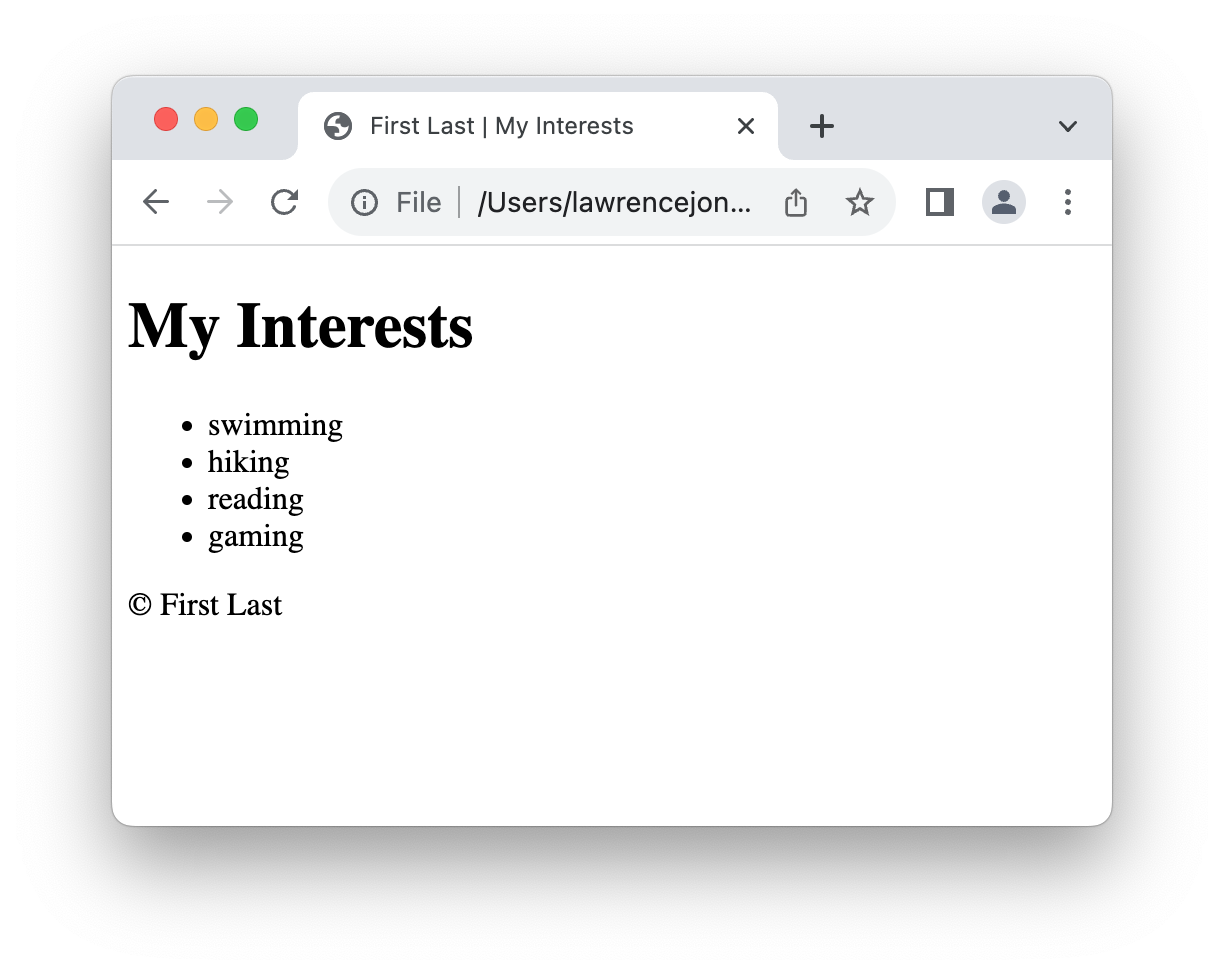05 | Assignment 05
concepts: working with plain text, html generation, DRY-concept via variables, f-strings, for loop, for loop nested between non-repeating strings, simple function definition, python module, import, and pycache
This is a full-fledged program that will challenge you to create something that is actually quite useful: A webpage generator. This primes us for moving on to more advanced programming concepts in the working with data module.
- Create a
lastname_first-initial_assignment_5folder. Inside of that folder, create a file namedinterests.html.
You do not need to understand HTML to do this assignment. Any small bits of knowledge you need will be provided. This is mostly a python project.
On the first line of interests.html enter
htmland pause. You will see some html choices presented. Choosehtml5. That will create a basic html page template for you.You should then see something like this:
<!DOCTYPE html>
<html lang="en">
<head>
<meta charset="UTF-8">
<meta name="viewport" content="width=device-width, initial-scale=1.0">
<title>Document</title>
</head>
<body>
</body>
</html>
- Rename the file to
interests.pyand then surround the all the text with an f-string like this:
print(f'''
<!DOCTYPE html>
<html lang="en">
<head>
<meta charset="UTF-8">
<meta name="viewport" content="width=device-width, initial-scale=1.0">
<title>Document</title>
</head>
<body>
</body>
</html>
''')
Save the file. Test the program and make sure it runs.
Next, create two variables at the top of the page:
# Not First Last, but your actual name. We will use this for
# title and copyright. The copyright html symbol is ©
name = 'First Last'
# we will use this for the title and the h1
page_topic = 'My Interests'
# Insert the variables in the multi-line f-string as shown below:
print(f'''
<!DOCTYPE html>
<html lang="en">
<head>
<meta charset="UTF-8">
<meta name="viewport" content="width=device-width, initial-scale=1.0">
<title>{name} | {page_topic}</title>
</head>
<body>
<h1>{page_topic}</h1>
© {name}
</body>
</html>
''')
- Save program and test to make sure you don't have any errors so far. You will notice that the variables are reused in a way that replication errors are reduced. This means that if the variables are set at the top, they will flow down into the text in a consistent manner.
This it the DRY concept: Don't Repeat Yourself. There is duplication of the variable, but there is not duplication of the variable contents: If you converted the variable to user
input()The user would only input the data once and everywhere that data was output, it would be the same. Web sites look very consistent across hundreds of pages. The same header and footer are used in every page. The best way to build a site like that is with the DRY principle. Developers create a web generator that will take the block of header code and footer code and use that exact code for every page. However, it is a bit complicated because some items in each block of code need to be different. This requires, loops, functions and variables as we are doing in this simplified assignment.
- Now create another file named
interests_module.py. In that folder you are going to create a loop for your interests. This is similar to what you did in assignment 2.
interests = ['swimming','hiking', 'reading', 'gaming']
for interest in interests:
print(interest)
We are going to import this list into the interests.html file.
- To do that we need to make this into a function by adding this line to the top of the loop:
def interests_loop():
Added:
def interests_loop():
interests = ['swimming','hiking', 'reading', 'gaming']
for interest in interests:
print(interest)
However, html requires that lists be contained in an ordered list <ol>, or an unordered list <ul> with <li> tags, like this:
<ul>
<li>item1</li>
<li>item2</li>
<li>item2</li>
</ul>
- Therefore, we need to edit the loop in the function and add these tags like this:
def interests_loop():
interests = ['swimming','hiking', 'reading', 'gaming']
print('<ul>') # Add this outside the loop: above
for interest in interests:
print(f'<li>{interest}</li>') # this will loop out multiple lines
print('</ul>') #Add this outside the loop: below
Your loop within the function is ready to be imported into the interests.py file.
- Go back to your
interests.pyfile and enter this line at the top:
from interests_module import interests_loop
- Finally, go to the bottom of the file and put the
interests_loop()function call under the theh1tag (The function will not run in the f-string. But you can make the one f-string into 2 f-strings above and below the function. The function will run fine and add the code where it needs to go.)
(f''' ... text
... text
... text
<body>
<h1>{page_topic}</h1>''') # you must terminate your f-string here.
# The function call cannot be in the f-string.
interests_loop()
# you need to start second f-string
print(f'''© {name}
</body>
</html>
''') # terminate second f-string.
Now you should be able to run your program an generate a web page from variables and a function:
<!DOCTYPE html>
<html lang="en">
<head>
<meta charset="UTF-8">
<meta name="viewport" content="width=device-width, initial-scale=1.0">
<title>First Last | My Interests</title>
</head>
<body>
<h1>My Interests</h1>
<ul>
<li> swimming </li>
<li> hiking </li>
<li> reading </li>
<li> gaming </li>
</ul>
© First Last
</body>
</html>
When your have the program working as intended, you will notice that you now have a new
__pycache__ folder containing an auto-generated binary .pyc file.

That is there because Python uses that file to run your code faster and without using as much of your system resources. Here is a pycache overview by Kana Mikami if you want to learn more about pycache.
- When finished, you should zip up your folder containing your files, including the file, and submit it for Assignment 05 in Canvas.
If you copy and paste the html into a file and name it interests.html and open it in a browser, you will see the webpage with the <h1>, the <ul> and <li> interest items, and copyright line with the symbol:

It's a lot of coding for just a little bit of output, but you now have the basics down to be able to build a much more sophisticated program.